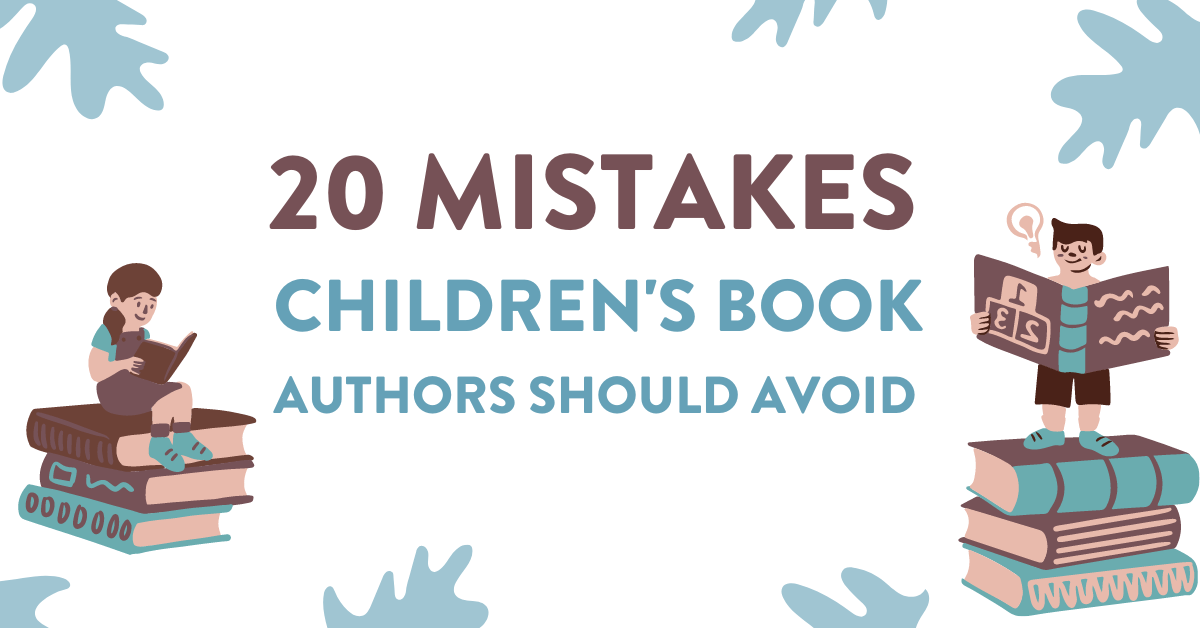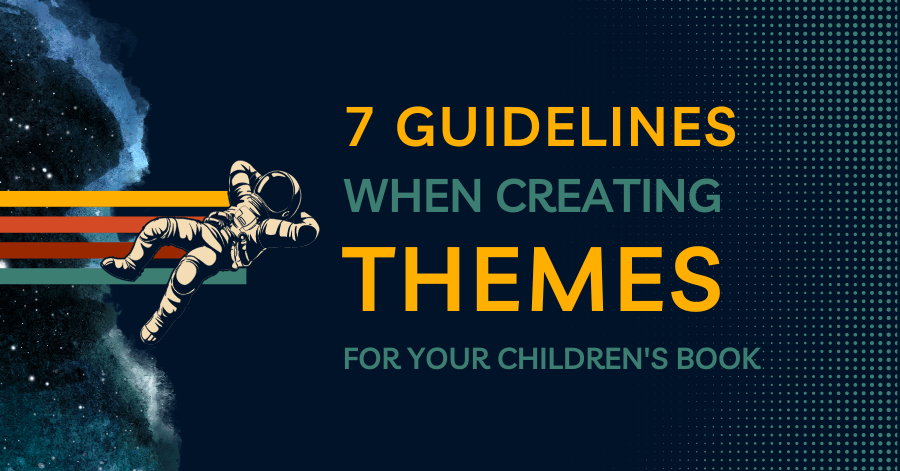
Hey there, budding children’s book writer! I know the magic and whimsy that writing for children can bring, but like any genre, it has its quirks and pitfalls.
I’ve seen a ton of talented writers stumble, trip, and sometimes get lost in the wonderful world of children’s literature. But don’t fret – I’m here to shed light on some common mistakes to help you avoid writing a bad book.
1. Mixing Up Genres
What’s the issue? So, you read a fascinating non-fiction book on ocean life and now you want to create a fictional tale about a fish named Finn. Great! But, if Finn starts narrating factual marine biology in detail, young readers might lose the plot.
If you want to write nonfiction, make it nonfiction. But if you’re going to write fiction, then you have to stick to the story and not let facts and figures overwhelm the plot.
Fix it: Go through each of your pages and ask yourself: does this page get me one step closer to the plot? Or does it only communication factual information that I can find on Wikipedia?
You want every page to be pushing the story forward, and only sprinkle in a few facts and a tiny bit of information as you move along.
2. Overwriting
What’s the issue? You’ve beautifully described the meadow, the chirping birds, and even the shade of blue in the sky. But wait! What about the illustrator?
Most children’s books I see end up trying to do all the work of communication. They don’t leave any space for the illustrator to work! This is a problem because:
- The illustrator doesn’t have anything left to communicate
- The amount of text fills up the page, not leaving enough room for illustrations
- The pacing feels too slow, and the child gets tired of the reading process
Fix it: Illustrations in children’s books are storytelling powerhouses. Leave some room for the artist to paint the picture. Collaborate.
If the text and illustrations complement each other, your story will truly come alive. Overwriting is a topic that most authors don’t think they struggle with, but 99% of the books I edit need to be trimmed down.
If you want to learn more about how to work with an illustrator, read my post, “12 Tips on Working with a Children’s Book Illustrator.”
3. Weak Characterization
What’s the issue? If your character lacks depth, whether it’s a squirrel or a spaceship or a little boy, readers might forget it by the next page turn.
A generic princess? Yawn. A princess who collects dragon stamps? Now you’re talking!
A little boy who’s lonely? Yawn. A little boy with wild hair who wears mismatched socks and sings to himself? Much better.
Fix it: Flesh out your characters. Give them dreams, quirks, and a signature move. Maybe they always twirl when excited or hum a unique tune. Make readers fall in love with them — not just a generic symbol of a child.
Get more advice on characterization by taking my children’s book course: “Two Weeks to Your Best Children’s Book.”
4. Books that Lecture
What’s the issue? Sometimes authors write children’s books because they get tired of admonishing their children:
- “Eat your vegetables.”
- “Share your toys.”
- “Don’t fight your brother.”
But you don’t want to put that lecturing inside a children’s book, because if your story starts to sound like a parenting manual, you might lose your audience. Kids, with their sharp little antennae, can sense didactic undertones from a mile away.
Fix it: Embed the lesson subtly. The key is balance. Let the story shine and if kids glean a life lesson or two, consider it a bonus!
And never give the moral on the story on the last page. This destroys the power of your story. Let the story give the lesson, rather than saying it explicitly.
5. Too Many Characters
What’s the issue? Jimmy, Timmy, Kimmy, Shimmy… Wait, who was Shimmy again?
Too many characters can confuse young readers and make your story harder to follow (even if their names don’t rhyme).
Do a litmus test on your book: how many characters are named in the entire book? If you have 7 or 8, that’s simply far too many. You’re going to confuse the reader and not have enough time to full develop those characters.
Fix it: Stick to a handful of strong, memorable characters. Ideally, two or three characters. (four is pushing it). Depth over breadth, always. Let each character serve a purpose and drive the narrative forward.
It’s often a good idea to combine characters. For instance, if you have two mentor characters, combine those so you only have one. If you have two sidekicks/friends, then combine them and only have one character.
6. Talking Down to Children
What’s the issue? Kids are far smarter and more perceptive than many give them credit for. If your narrative is patronizing or overly simplistic, they’ll likely switch off.
Fix it: Write with respect. Simplify language when needed, but don’t dumb down concepts. Trust in their intelligence and capacity to understand. It’s okay to use subtlety and hint at things, rather than spelling everything out.
Look at a book like “The Giving Tree.” The book doesn’t tell the reader that the tree is a parent. But kids either figure it out, or they sense the tree is like a parent.
7. Copying Famous Kid Books
What’s the issue? We get it. Who doesn’t want to recreate the magic of ‘Harry Potter’, ‘Where the Wild Things Are’, or ‘The Very Hungry Caterpillar’?
But if your ‘Barry Botter’ is a clear doppelganger, it’s a no-go.
Fix it: Seek inspiration, but forge your own path. What unique perspective or twist can you bring to the table? That’s what will make your book stand out.
Ultimately, you might need to read a lot more books in order not to copy a famous one. People often copy because they just don’t have enough stories in their brain, and if they add a couple hundred more, then they have enough to draw from to create something original.
8. Characters Without Agency
What’s the issue? Imagine reading about Lucy’s quest to find a magical stone. Just as she’s about to face the big challenge, her friend does it for her. Anti-climactic, right?
But this is the most common problem I see as a children’s book editor. Usually, it’s the parents who solve the problems for the kids, and I have to gently remind the author that in a children’s book, the kid gets to be the hero.
Fix it: Main characters should drive the story. They should be the ones facing challenges, making decisions, and experiencing growth. Let them be the heroes of their own tales.
9. Inconsistent Voice
What’s the issue? Imagine starting off with a tone reminiscent of Dr. Seuss and suddenly switching to something that sounds like Roald Dahl. Confused? So will be your readers.
Consider Dr. Seuss’s “Green Eggs and Ham” and its playful, repetitive rhyme. Now imagine if midway, it adopted the darker, more narrative tone of Dahl’s “The Witches”. Quite the mismatch, right?
Most authors who try to write poetry make this mistake. If you write poetry, you have to stick to the:
- exact same stanza length for the whole book (four lines is common — but don’t switch between 4 and 5 and 6)
- stick to the same rhyme scheme for the whole book (AABB, or ABCB, or whatever)
Fix it: Establish a tone early on and be consistent. Whether you’re going for humorous, whimsical, serious, or mysterious, stick to it throughout.
10. Ignoring Age Groups
What’s the issue? Writing a tale with sophisticated themes and complex vocabulary might not resonate with a 4-year-old, while a simplistic story could bore a 10-year-old.
“Goodnight Moon” by Margaret Wise Brown is perfect for toddlers with its repetitive text and simple illustrations. “Harry Potter and the Sorcerer’s Stone”, on the other hand, caters to older kids with its intricate plot and character dynamics.
Fix it: Identify your target age group. Research their interests, reading levels, and comprehension abilities. Craft your story to suit them.
And since age groups are so hard to get right, check out my longer post on this, “How to Write a Children’s Book in 12 Steps.”
11. Forgetting Humor
What’s the issue? Kids love to laugh. If your story is continually somber without light-hearted moments, you might miss a golden opportunity to connect.
“Don’t Let the Pigeon Drive the Bus!” by Mo Willems is a perfect example of humor done right. The pigeon’s persistent and hilarious attempts to drive the bus are sure to evoke giggles.
Fix it: Infuse your narrative with humor. It doesn’t always have to be slapstick or overt; sometimes, subtle humor works wonders.
Potty humor and physical pratfalls are always sure to get kids laughing out loud — try those first.
12. Overcomplicating the Plot
What’s the issue? An intricate plot with too many twists and turns can leave young readers behind, leading to a disconnected reading experience.
While “The Chronicles of Narnia” by C.S. Lewis is a rich and intricate series, Lewis ensures that each book’s core plot remains clear and focused, making it accessible to young readers.
Fix it: Simplicity is key. Keep the core of your story clear and straightforward, even if the world around it is expansive.
13. Not Reading Aloud
What’s the issue? Children’s books often come alive during read-aloud sessions. If the flow feels off when spoken, it can hinder the reading experience.
“Brown Bear, Brown Bear, What Do You See?” by Bill Martin Jr. and Eric Carle flows seamlessly when read aloud, making it a favorite among kids and adults.
When I edit for my clients, I always read each book out loud to make sure it flows well. Before you publish your children’s book, you should definitely read it out loud not only to yourself, but to several groups of children to see their reaction.
Fix it: Read your story out loud, multiple times. Better yet, have someone read it to you. Note where they stumble or pause and refine those sections.
14. Skipping Real-life Issues
What’s the issue? Just because they’re young doesn’t mean children don’t grapple with real-life challenges. Overly sanitized stories might feel inauthentic.
“The Invisible String” by Patrice Karst addresses the issue of separation anxiety, helping kids understand the unbreakable connections between loved ones.
Fix it: Address real challenges, emotions, and situations. Ensure you present them with sensitivity, framing them in a way that’s comprehensible and comforting to children.
15. Neglecting Diversity
What’s the issue? Children’s books should be mirrors and windows – reflecting kids’ own experiences and offering views into others’ lives. Without diversity, you’re limiting their world.
Most publishers won’t consider books that aren’t diverse. And if you’re self publishing, then you want a potentially wide audience for your book, and you get through through featuring a diverse cast of characters.
For example, “Last Stop on Market Street” by Matt de la Peña takes readers on a journey through a diverse urban setting, showcasing various cultures, backgrounds, and perspectives. But really, any book featuring a diverse cast of races will help your audience of children to see themselves in your book.
Fix it: Incorporate diverse characters, settings, and themes. Let children experience the vast, colorful tapestry of the world through your story.
16. Chasing Trends
What’s the issue? So, racial topics or slime adventures are the talk of the town. But if you jump on a trend purely because it’s hot, your story might lack authenticity.
Plus, publishers usually have more than a one-year lead time. What is trendy right now might not be trendy more than a year from now. Even if you self publish, it takes about four or five months to get your illustrations done.
Fix it: It’s better not to chase a trend, but work on a topic that’s meaningful to you. While trends are fantastic for inspiration, just ensure that the heart of your tale is something you truly resonate with. If you can weave in racial topics or slime authentically? More power to you!
17. Forgetting the Adult Reader
What’s the issue? Remember, in many cases, it’s an adult who’s reading the story out loud. If they’re yawning through it, chances are the enthusiasm won’t trickle down.
Examples: Think of the delightful wordplay in “The Day the Crayons Quit” by Drew Daywalt. It not only captures kids’ imagination but also tickles the adult reader, making storytime engaging for all.
Fix it: Add layers. A joke or reference that flies over kids’ heads but makes adults chuckle can be a masterstroke.
18. Making Every Ending Happy
What’s the issue? Happy endings are great, but sometimes, stories that conclude with a touch of reality, or even a gentle cliffhanger, can be more impactful.
I often tell children’s book authors to try a “bittersweet” ending. This is an ending with one happy element and one kind of sad element.
But of course there’s nothing wrong with a happy ending — just determine whether it’s right for your book.
Fix it: Don’t force a rosy conclusion. Let your story’s end be true to its narrative. If it’s bittersweet or thought-provoking, trust your readers to handle it.
19. Avoiding Conflict Altogether
What’s the issue? It’s natural for us to avoid conflict (more natural for some of us than others!).
But without any obstacles, challenges, or conflicts, your story may lack the depth or momentum needed to keep readers hooked.
Examples: “Where the Wild Things Are” by Maurice Sendak doesn’t shy away from Max’s conflicts – both internal (with his emotions) and external (with the Wild Things). This tension is crucial for the story’s progression and resolution.
Fix it: Embrace conflict. Whether it’s a dragon to be tamed, a mystery to be solved, or an emotion to be understood – let your characters face it and grow from the experience.
Start the conflict AS SOON AS POSSIBLE! I’m talking about on page one or two, not page four.
20. Assuming It’s Easier than Writing for Adults
What’s the issue? Many assume that writing for kids is a cakewalk, given the shorter lengths and simpler vocabulary. But mastering the art of children’s literature is no less challenging than penning an epic for adults.
When I give feedback to authors, they’re often surprised that my feedback is longer than their book! That’s because there are so many things that you need to get right.
Fix it: Approach children’s literature with the same respect and dedication as you would any other genre. It requires understanding the psychology of kids, mastering brevity while being impactful, and keeping up with their ever-changing world.
And consider hiring a professional children’s book editor. They’re going to see 10,000 things that you never ever would have considered.
Publish Your Book
Hey, do you have a children’s book you want to publish? Bookfox Press can help you.
We take first-time authors just like you and help them with editing, with illustrations, with formatting, and everything else that goes into a successful children’s book. Reach out to us to see how we can help you.
There you have it! Those were the most common mistakes you’ll want to avoid when crafting your children’s book. Remember, every writer, no matter how experienced, is continually learning. So, take these tips, blend them with your unique style, and create something truly magical. Happy writing!




One thought on “20 Mistakes Children’s Book Authors Should Avoid”
I found the above steps useful. Thanks a lot.